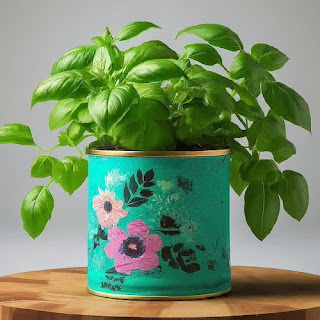Materials:
Empty tin can (clean and dry)
Hammer and nail (or drill)
Paint (acrylic or spray paint recommended)
Paintbrush (optional for acrylic paint)
Stencils or decoupage paper (optional for decoration)
Potting soil
Herb seedlings or seeds (such as basil, mint, parsley, oregano, thyme)
Spoon
Instructions:
- Prepare the Tin Can: Wash the empty tin can thoroughly with warm soapy water to remove any labels or residue. Dry it completely.
- Drainage Holes: Using a hammer and nail (or drill), create several small holes in the bottom of the tin can for proper drainage. This is crucial to prevent water-logging and root rot for your herbs.
- Painting and Decorating (Optional): If you want a decorative touch, unleash your creativity! Paint the tin can with a solid colour or use stencils or decoupage paper with floral patterns for a more personalised look. Let the paint dry completely before proceeding.
- Planting the Herbs: Fill the tin can with potting soil, leaving about an inch of space at the top.
- Herb Selection: Choose your favourite herbs! Popular options for tin can herb gardens include basil, mint, parsley, oregano, and thyme. Consider the amount of sunlight your windowsill receives and choose herbs that thrive in those conditions.
- Planting Seeds or Seedlings: If using seeds, sprinkle them on the soil surface according to packet instructions and gently press them in. If using seedlings, carefully dig a small hole in the soil, place the seedling in the hole, and fill in the space with soil around the base of the plant.
- Watering: Water your newly planted herbs until the water drains out of the holes at the bottom. Avoid overwatering, as this can damage the roots.
- Sunlight: Place your tin can herb garden on a sunny windowsill that receives at least 6 hours of sunlight daily.
- Harvesting: Once your herbs have grown, you can start harvesting them by snipping off leaves as needed.
Tips:
- Choose a tin can size that is appropriate for the herb you are planting. Larger herbs like basil may need a bigger can.
- Use a spoon to loosen the soil slightly before planting seeds to create a shallow furrow for them.
- Water regularly, but avoid letting the soil become soggy.
- Feed your herbs occasionally with a balanced liquid fertiliser according to the package instructions.
- Depending on the herb variety, you can harvest throughout the growing season by pinching off leaves regularly. This encourages bushier growth.
- Repurpose other containers like coffee cans or tins for a collection of mini herb gardens on your windowsill.
- Upcycled tin can herb gardens are a fun and sustainable way to grow fresh herbs for your culinary creations. Enjoy the convenience and satisfaction of having fresh herbs readily available in your kitchen!




